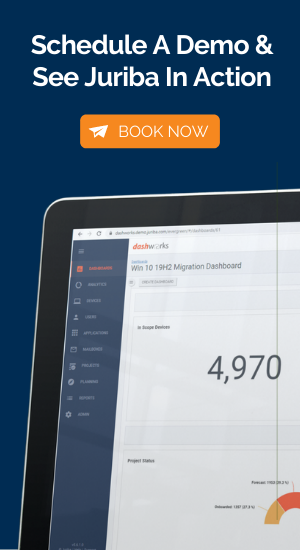According to Gartner's most recent Digital Workplace maturity research, 25% of organizations still have limited insight on their digital workplace operations and 58% have the basics covered but are still in reactive mode as they look towards a more proactive and automated future. The current goal of those organizations is to provide more consistent and measurable service offerings with basic process improvements. A huge 83% of organizations are at this stage right now.
As you progress from modernizing your workplace infrastructure, where efforts are primarily focused on keeping up with OS security patches and updates, managing change and service requests, taking care of incidents, and managing your growing hardware estate, to operational excellence, your focus changes to enabling new ways of working. As digital workplace maturity evolves, you can drive a consolidation of IT resources as well as IT management tools. You move away from being a manager of technology and become an enabler of business productivity and employee engagement.
As you shift to enabling your employees' technology experience and digital dexterity, measurement and reporting become a critical element of your IT service success. To help define those metrics that matter I have identified 13 crucial KPIs that you need to track across four categories that will help you understand the efficiency, experience, and success of your digital workplace maturity journey.
Employee Experience KPIs
Today, employee experience is a critical measure in today's dynamic digital workplace. By understanding how your employees experience the digital workplace, organizations can tailor their digital infrastructure to better meet the nuanced needs of their workforce. These KPIs not only reflect the current state of employee satisfaction, but also provide indicators for achieving an enhanced, productive, and engaged digital workplace.
Employee Net Promoter Score (eNPS) of technology & IT services
The employee net promoter score measures the willingness of employees to recommend their organization's IT services to others. It takes the form of a single question something like "How likely are you to recommend <your organization's> IT services to a colleague"? A high NPS indicates strong employee satisfaction with the IT services and technology provided, which can lead to higher productivity and lower staff turnover. For the digital workplace leader, this metric is one of the best indicators that users are satisfied with the team's work.
Digital Experience Index (DEX)
The Digital Experience Index score is a composite metric that assesses the overall digital experience provided by the organization's technology stack. It is a comprehensive indicator of how digital tools enhance or hinder employee productivity and satisfaction. DEX scores are usually provided by paid tools such as Nexthink, Lakeside Systrack and Aternity (Riverbed).
Employee Engagement Surveys
Employee engagement surveys capture employee feedback on IT service management processes, including the resolution of support tickets/IT issues, change requests, and the implementation of proactive project-based programs. This feedback helps IT to continuously improve service delivery and align IT projects with user needs, directly impacting workforce efficiency. These surveys should be routinely captured upon IT related change events and aggregated into overall metrics aligned to the different services available.
Self-Service Capability
Self-service capability measures the extent to which employees can manage their IT service needs independently, without direct IT support. This is important because robust self-service options empower employees, reduce support costs, and lead to faster resolution times, thereby improving the overall digital workplace experience.
As organizations strive to enhance their digital workplace, these employee experience insights provide a clear understanding of how effectively the digital environment supports and enhances employees' daily work lives. This metric is hard to quantify but can be established by a review of all IT services and a scoring matrix on self-service availability.
Change Management KPIs
Understanding the intricacies of change management is crucial as organizations progress in their digital transformation maturity. KPIs related to change management provide insights into technology adoption, the effectiveness of our change management processes, and the efficiency with which new technologies and procedures are implemented.
Technology Adoption
Technology adoption metrics (e.g., UEM adoption, OS adoption) track the uptake and integration of new technologies, such as Virtual Desktop Infrastructure (VDI)/Desktop-as-a-Service (DaaS) and operating systems like Windows 11 within the organization. This is crucial because high adoption rates indicate successful rollouts and user buy-in, which are essential for realizing the benefits of IT investments and maintaining a modern workplace. These metrics can be obtained through existing inventory systems.
Employee Satisfaction with the Change Management Process
Employee Satisfaction with the Change Management Process measures how employees perceive the effectiveness and efficiency of the process through which IT changes are planned, communicated, and executed. Employee satisfaction in this area reflects the ability of IT change management to deliver improvements without causing disruption, which is key to maintaining high productivity and morale. These would be surveys delivered following major change events such as an end user platform change to DaaS.
Time To Implement
This KPI tracks the time it takes to implement new technologies and initiate new IT processes, such as onboarding new employees, fulfilling new or existing application requests, or ordering new assets. Shorter implementation times indicate a responsive and agile IT environment that supports rapid adaptation to new workflows and tools, fostering a dynamic and competitive business. You can highlight a few critical and repeatable processes within your organization and create initiatives to drive down the delivery time for the end user.
In summary, change management KPIs offer clear evidence of progress and pinpoint opportunities for refinement as we continuously evolve and adapt to the future of work.
Automation Adoption KPIs
The efficiency and effectiveness of managing a digital workplace are increasingly measured by the grade of automation used. By evaluating the number of automated tasks, the time saved through automation, and the reduction in errors thanks to these advancements, organizations can gain valuable insights into the performance and maturity of their digital workplace management.
Number of automated tasks
This KPI tracks the quantity of IT management tasks that have been transitioned from manual to automated processes. Some examples of automated tasks tracked for automation are device recovery, device procurement, OS updates, and application updates. A greater number of automated tasks typically correlates with increased operational efficiency and allows IT staff to focus on more strategic initiatives. Our suggestion here is to highlight any area where repetitive tasks are undertaken and simply count them to show increasing levels of automation maturity.
Time saved by automation (in %)
This KPI measures the percentage of time reduction achieved by automating processes compared to performing the same tasks manually. This KPI highlights the direct impact of automation on productivity, showing how it can free up significant time and resources across the organization. These measures should be continually assessed and updated to further drive down wait time for the service consumer.
Reduction in errors due to automation
This metric compares the frequency of errors or issues caused by manual process reported before against the same metric after implementing automated change-related activities. This indicates the enhancement in reliability and quality control within IT processes, resulting in improved service stability and user satisfaction.
The adoption of automation in digital workplace management is a transformative shift from trying to keep up with operational processes towards being able to proactively empower new ways to work. As companies continue to evolve, these metrics will serve as guideposts, ensuring that the trajectory toward a more efficient, error-resistant, and productive digital ecosystem remains clear and focused on continuous improvement.
Compliance KPIs
Managing compliance within the digital workplace requires a careful balance of vigilance and comprehensive reporting strategies. Compliance-related KPIs play a pivotal role in safeguarding a compliant and secure digital infrastructure as they help organizations gauge and uphold adherence to a range of audit, regulatory and legal standards.
Number of compliance incidents
The number of compliance incidents measures the frequency of incidents where the organization fails to meet compliance standards in areas such as software licensing and vulnerability management. Monitoring compliance incidents helps ensure adherence to legal and regulatory standards, which can mitigate risk and avoid potential fines or legal consequences. In most cases, these metrics can be supplied by third party tools that scan the environment continuously.
IT environment visibility and observability
An IT environment visibility and observability score assesses the accuracy and thoroughness of the organization's IT asset management, including the accuracy of device, software, and OS inventory, tracking of lost devices per annum (and their recoverability), as well as the monitoring of vulnerabilities. Strong visibility and observability are vital for managing risks, optimizing asset use, and ensuring a secure IT environment against internal and external threats.
Time to investigate and resolve compliance incidents
This KPI measures the duration from the identification of a compliance issue to its resolution. Quick resolution times are indicative of an agile and responsive compliance framework, which is crucial for maintaining operational integrity and minimizing the impact of compliance-related disruptions.
Achieving a compliant digital workplace is an ongoing initiative that requires constant vigilance in monitoring compliance KPIs and taking proactive measures based on the insights they provide. By consistently keeping compliance incidents to a minimum, maintaining a strong level of visibility and observability in the IT environment, and swiftly addressing any issues that arise, organizations can safeguard the integrity of their operations and safeguard their valuable assets.
Conclusion
As you progress in your digital workplace journey, how you measure the success of your team's work will change drastically. You will move from basic KPIs such as problem ticket and service request volumes to measuring employee experience, change management effectiveness, automation adoption, and compliance. By tracking the right KPIs, you can measure your progress and identify areas where you need to improve. This will help you to ensure that your IT investments are helping you to achieve your business goals.
To effectively track and report on these metrics, organizations can leverage Digital Platform Conductor platforms like Juriba, which are specifically designed for managing the digital workplace. These tools provide cohesive insights and enable organizations to extract tangible business value from their IT investments. So, if you're looking to take your digital workplace to the next level, consider leveraging the right tooling and start measuring and optimizing these crucial KPIs for a more productive and engaging digital workplace.
Take the assessment and begin your journey to improved digital workplace operational efficiency
Subscribe to our blog:
.png?width=250&height=79&name=Juriba%202015%20Logo%20(Large%20-%202214x700).png)

